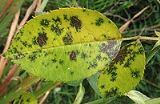
Diplocarpon rosae
Encyclopedia
Diplocarpon rosae is a fungus
that causes the rose
disease Black Spot.
Because it was observed by people of various countries around the same time (around 1830), the nomenclature for the fungus varied with about 25 different names. The asexual stage is now known to be Marssonina rosae while the sexual and most common stage is known as Diplocarpon rosae.
Diplocarpon rosae over seasons as mycelia, ascospore
s, and conidia in infected leaves and canes. In the spring during moist, humid conditions, ascospores and conidia are wind-borne and rain splashed to newly emerging leaf tissue. Upon infection, disease progresses from the lowest leaves upward causing defoliation and black spots on leaves.
of the roses may become affected if untreated, and will cause progressive weakening of the rose.
is effective both against black spot and as an insecticide against aphids. It is usually necessary to repeat the spraying at 7 to 10 day intervals throughout the warmest part of the growing season, as the fungus is most active at temperatures from 75 to 90 degrees Fahrenheit.
Fungus
A fungus is a member of a large group of eukaryotic organisms that includes microorganisms such as yeasts and molds , as well as the more familiar mushrooms. These organisms are classified as a kingdom, Fungi, which is separate from plants, animals, and bacteria...
that causes the rose
Rose
A rose is a woody perennial of the genus Rosa, within the family Rosaceae. There are over 100 species. They form a group of erect shrubs, and climbing or trailing plants, with stems that are often armed with sharp prickles. Flowers are large and showy, in colours ranging from white through yellows...
disease Black Spot.
Because it was observed by people of various countries around the same time (around 1830), the nomenclature for the fungus varied with about 25 different names. The asexual stage is now known to be Marssonina rosae while the sexual and most common stage is known as Diplocarpon rosae.
Diplocarpon rosae over seasons as mycelia, ascospore
Ascospore
An ascospore is a spore contained in an ascus or that was produced inside an ascus. This kind of spore is specific to fungi classified as ascomycetes ....
s, and conidia in infected leaves and canes. In the spring during moist, humid conditions, ascospores and conidia are wind-borne and rain splashed to newly emerging leaf tissue. Upon infection, disease progresses from the lowest leaves upward causing defoliation and black spots on leaves.
Diagnosis
The black spots are circular with a perforated edge, and reach a diameter of 14mm. Badly affected plants, however, will not show the circular patterning, as they combine to cause a large black mass. The common treatment of the disease is to remove the affected leaves and spray with anti-fungal solutions. Some stemsPlant stem
A stem is one of two main structural axes of a vascular plant. The stem is normally divided into nodes and internodes, the nodes hold buds which grow into one or more leaves, inflorescence , conifer cones, roots, other stems etc. The internodes distance one node from another...
of the roses may become affected if untreated, and will cause progressive weakening of the rose.
Treatment
Removing infected leaves from the plant and fallen leaves from the ground will slow the spread of the infection, as does avoiding wetting the leaves of plants during watering. An infected plant can be removed from the area, which will slow the spread of infection to other plants, but this often is not desirable. Fungicides, such as mancozeb, chlorothalonil, flutriafol, penconazole, or a copper based product, applied upon new leaf emergence or first appearance of black spot can be used to control the disease. If a more natural and nontoxic approach is desired, diluted neem oilNeem oil
Neem oil is a vegetable oil pressed from the fruits and seeds of the neem , an evergreen tree which is endemic to the Indian subcontinent and has been introduced to many other areas in the tropics...
is effective both against black spot and as an insecticide against aphids. It is usually necessary to repeat the spraying at 7 to 10 day intervals throughout the warmest part of the growing season, as the fungus is most active at temperatures from 75 to 90 degrees Fahrenheit.

